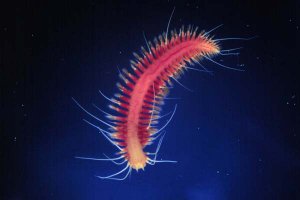Hesiocaeca methanicola
| Hesiocaeca methanicola | ||||||||||||
|---|---|---|---|---|---|---|---|---|---|---|---|---|

Hesiocaeca methanicola |
||||||||||||
| Systematics | ||||||||||||
|
||||||||||||
| Scientific name | ||||||||||||
| Hesiocaeca methanicola | ||||||||||||
| Desbruyères & Toulmond , 1998 |
Hesiocaeca methanicola , also known as ice worm , is a polyextremophilic species of polychaeta that occurson methane hydrate fields . The first description was in 1998 by Daniel Desbruyères and André Toulmond .
Description and way of life
The polychaet was discovered in 1997 by Charles R. Fisher during a research trip with a Johnson Sea Link submersible at a depth of 800 meters at the bottom of the Gulf of Mexico , 150 miles south of New Orleans . H. methanicola occupied the surface of the methane hydrate with an individual density of about 2500 specimens per square meter.
The flat body of H. methanicola is 2–4 cm long, colored pale pink and densely covered with bristles. The funnel-shaped mouth has a diameter of about 2 mm. In the habitat of H. methanicola there is a lack of oxygen, low temperatures (7 ° C) and extreme pressure, conditions to which this deep-sea worm is apparently very well adapted. It is still unclear whether the worm feeds directly on methanophilic bacteria or via a symbiotic community, similar to that of beard worms .
In experiments conducted by Fisher, the worm survived up to 96 hours in an anoxic environment. Fisher was able to show in experiments that the larvae of the worm spread with the current and that they have 20 days to search for a new living environment, which they can survive without ingesting food.
distribution
H. methanicola has so far only been found in the Gulf of Mexico, due to the worldwide distribution of methane hydrate fields and their fragmentary research, the size of the distribution area has yet to be clarified.
Individual evidence
- ↑ D. Desbruyères & A. Toulmond: A new species of worm hesionid, hesiocaeca methanicola sp. nov. (Polychaeta: Hesionidae), living in ice-like methane hydrates in the deep Gulf of Mexico. In: Cahiers de Biologie Marine , Vol. 39, pp. 93-98, 1998.
- ↑ CR Fisher, IR MacDonald, R. Sassen, CM Young, SA Macko, S. Hourdez, RS Carney, S. Joye, E. McMullin: Methane Ice Worms: Hesiocaeca methanicola Colonizing Fossil Fuel Reserves . In: The natural sciences . tape 87 , no. 4 , April 2000, pp. 184-187 , doi : 10.1007 / s001140050700 .
- ↑ a b c Barbara Kennedy: Scientists Discover Methane Ice Worms on Gulf of Mexico Sea Floor PenState Science (Engl.)
- ↑ SpaceRef: Redefining "Life as We Know it"

